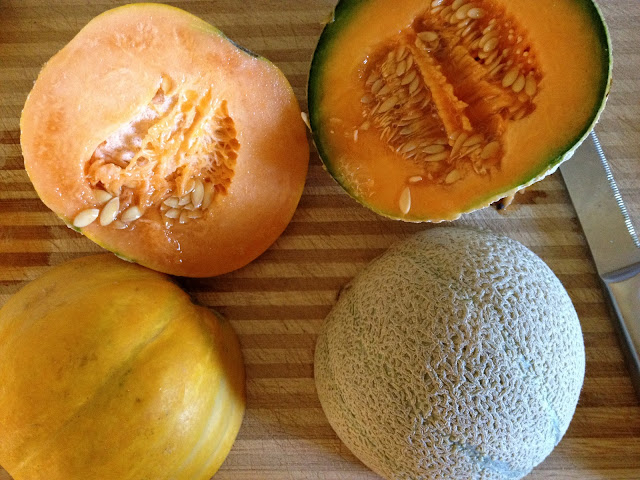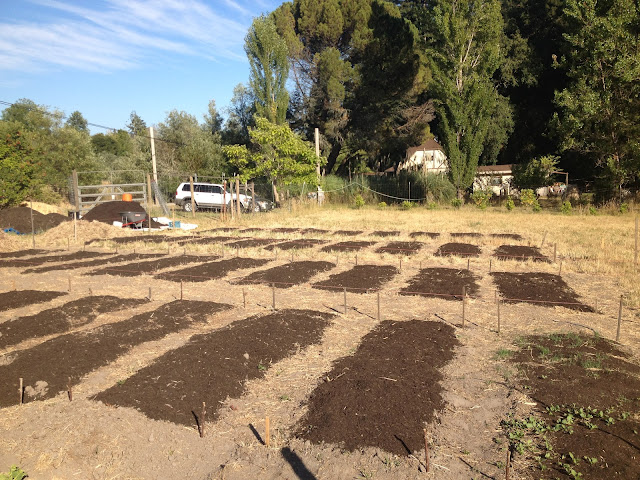For the last month or two we have been hard at work with expanding into our lower quarter acre. This space has been left fallow for a few years and has been relegated to weedy grasses and uneven compacted soil. It also happens to be the low spot within the fenced in garden space, so in the winter it will be pretty wet. But, if we want to be able to provide food for more than just ourselves and share with the community and friends then we need to continue our step by step expansion into the lower quarter.
Here's what the lower quarter looked like July 6th. As you can see on the right there is a compost pile and then moving left we see some stakes that are end markers for some of our blocks and pathways. All the way down to the end we have the last of the scythed grasses before we ended up raking them into the huge pile.
On July 7th we had scraped the rest of a block and started some more raking
By July 21st we had a second block already scraped and raked in the morning,
and by the afternoon we were continuing to hoe a third block
And by this point in the afternoon we were so excited to be scraping the last little bit that we actually documented it with a photo! Yeah 3 blocks scraped!
On July 22nd we had some wonderful guests for a farm visit so we didn't get much work done, but we had music time and wine and a taste test our first snacky veggies of summer squash and peppers!
Most of the summer squash was about this size. A few days later they had tripled, quadrupled in size!!
On July 23rd we got a new shipment of compost.
This stuff is way more quality stuff compared to the "organic" compost I mentioned we got cheaply from the city. I mentioned before that we would spend lots of time sifting the compost to get rid of the plastic and other trash in there. Well, here's about a 5 gallon bucket half full of the junk:
Nasty, huh?
And here's the new compost which is way better (and goofy me showing it all 10 yards of it off)
The next step was to rake off all the rest of the scrapings into piles and start bringing 1 wheelbarrow of compost to each bed.
By July 25th we had 4 blocks looking like so
By July 28th we were ready to spread our powders and dig the beds
We figured out that if we actually kept things up we could dig a block in one day, but that never really happens as other tasks sometimes slow us down (or the heat). One thing that really slowed us down though was the compaction of the soil. In order to overcome this we had to water the areas we would be digging. We watered over multiple days and for long enough periods of time to soak in enough for our forks to penetrate this compaction.
But, by August 4th we were ready to put in the lines of irrigation for these new beds. The plan is to cover crop them for the summer and then use that green material to start building our compost piles. It was difficult to find summer cover crops that were organic. We settled on a pound of organic soybeans. This got us through one block plus two beds in the next block, each with 3 rows per bed and about a 2 inch spacing between beans.
By August 12th we had our first soybeans germinating.
We had some more guests for a nice family vacation during that week and you can just see how big that squash ends up getting if you don't pick it every couple of days. It's as big as the kids!
They enjoyed playing in the hay bale fort
Touring the farm
and watering the new beds (and even trying out the forks for digging)!
In other news around the farm...
our produce is just starting to really come to fruition (pun intended) and we are starting to harvest lots of goodies to share with friends and neighbors. Be sure and stop by or ask us if we've got any sun ripened and sweet Chadwick cherry tomatoes, or the tasty Nyagous or maybe even some Moonglow tomatoes! Also ready are our American Flag leeks and Australian Brown onions and lovely cipollinis. Not to mention the still going strong Costata Romanesca summer squashes. We've also got some chioggia beets. Oh and herbs... and green beans....
We will continue to expand our lower quarter and look forward to sharing more with all of you!





















































